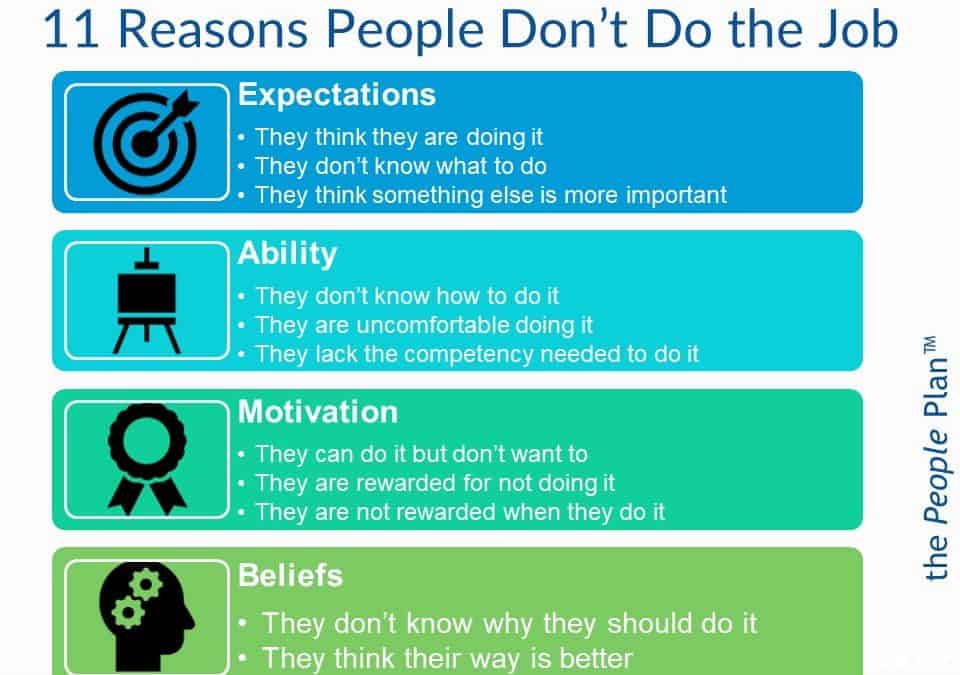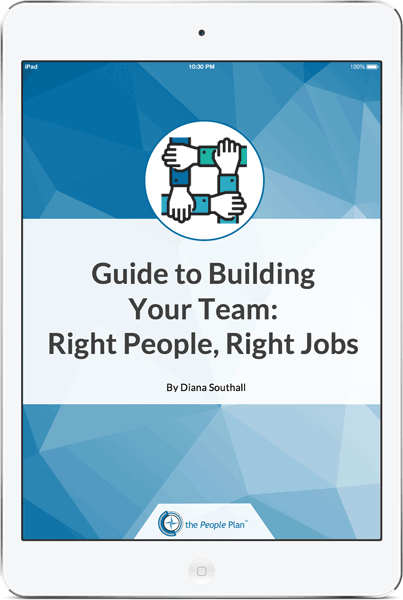
11 Reasons Why Employees Don’t Do the Job
Determining the cause of a performance issue can be like being a detective– here is a list of 11 major reasons employees “don’t do the job” with possible solutions.
Source: Expectations
1. They don’t know what to do
2. They think they are doing it
Solution: I read many job descriptions—hundreds per year from dozens of organizations—rarely do they clarify for me the specific job activities and key results areas, much less how the job will be measured. It is difficult to hold someone accountable to results when the manager has not made it crystal clear what those results should be and what s/he has to do to get those results. Otherwise employees just take their best guess and do what seems to be the most urgent.
3. They think something else is more important
Solution: A great survey report showed that employees only agree with managers on 1 out of 3 priorities! Frequent coaching and follow up makes sure that what a person is working on is the highest priority for the job and department. An employee does the best she can reading the tea leaves to guess what her manager thinks is priority. Don’t make them guess… also, remember employees often don’t have the broader view or much information outside of their own activities (and yes, the more they do the better decisions they will make.)
Source: Training
4. They don’t know how to do it
Solution: Work with employee to identify skill or competency to enhance with training, create a training plan with a timeline and hold employee accountable to stick to the plan (even if it means reminding her manager to schedule the time or resources).
5. They are uncomfortable doing it
Solution: Sometimes a little training can increase someone’s confidence and they become “comfortable” with the task and then perform it regularly. More likely this is a symptom of job fit—someone’s personality traits or competencies are not aligned with those required to excel in the job. A classic example is “asking for the sale”— a person who is cooperative (lower assertive) can be trained for years on sales techniques and given scripts, but he is always uncomfortable closing. For job fit, the remedy is to change the job duties to ones that correspond with the person’s strengths and attributes.
6. They lack the competency needed to do it
Solution: Depending on the type of competency, the person may benefit from more training and development. However, many competencies are a function of personality traits that are ingrained and difficult to change even with extensive training. For example, “planning and organizing” is a set of traits and habits that your employee may not have and will be challenged to overcome in a role that requires tracking and pacing their work on month-long project. In many cases, the solution is finding a better job fit for the incumbent’s competencies.
Source: Feedback/ Recognition
7. They can do it but don’t want to
8. They are rewarded for not doing it
9. They are not rewarded when they do it
Solution: This is fundamental psychology. People do what is measured and recognized and rewarded. If they are not rewarded (or worse, “punished”) for doing something, most people stop doing it. Sales people don’t like to do paperwork—but they also don’t want to be reminded that they were late 9 of the last 10 weeks—this is powerful feedback.
Often the signals sent by managers are unintended. Do you reward your poor performers by giving extra work to others that you can depend on? Do you remember to praise and even publicly recognize the team that worked last weekend to finish up a project?
Source: Belief
10. They don’t know why they should do it
Solution: Some people will blindly follow rules, but most want to know the “why” behind something that they are asked to do. It they believe a task or process is x (insert label here: low importance, arbitrary, a waste of time, or just plain stupid), no amount of training will effect a change in behavior. You might get begrudging compliance but that is about it. To get commitment, you have to explain the “why” to change the belief. (Until they believe his IS important, worth my time, etc.)
11. They think their way is better.
Solution: Read the solution above… plus this often happens when you ask someone who is good/ comfortable with the “old way” and now you have a “new way.” And in the beginning, the old way is better since an employee is more comfortable and competent in the old way. A big part of culture change and process change is to overcome the belief that the old way is better.
A key personality trait is openness to new experiences and some people are not. They will cling to the things they know how to do. As a manager you will need to support and coach these employees through the pain and fear that comes with change. Recognize that this is more deep seeded than just a training issue, but a consistent personality trait or a cognitive filter (belief) and be patient and supportive, and work through changing the belief, not just behavior.
As a client’s manager once stated, “if we have 100 people then we have 100 different personalities.” It’s your job as a manager to figure out what is the cause and the solution that works for all the unique individuals on your team.












